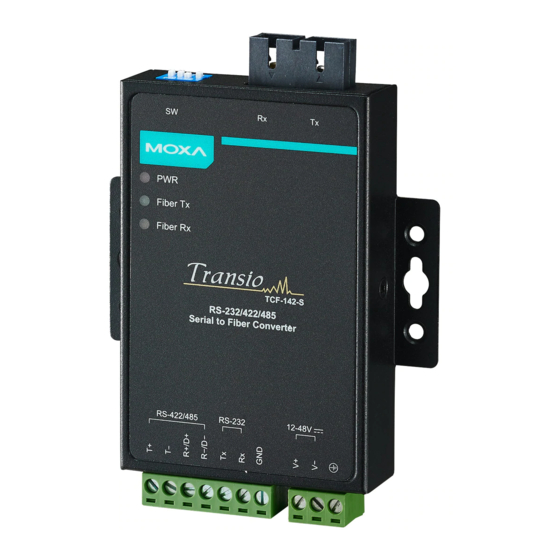
Table of Contents
Advertisement
Quick Links
TCF-142-S, TCF-142-M
RS-232/422/485 to Fiber Converter User's Manual
Second Edition, December 2003
1. Overview
Introduction
The TCF-142 series converter is equipped with a multiple interface
circuit that can handle RS-232, or RS-422/485 serial interfaces and multi-
mode or single-mode fiber. TCF-142 converters are used to extend serial
transmission distance up to 2 km (TCF-142-M multi-mode fiber) or up to
20 km (TCF-142-S single-mode fiber). RS-232 or RS-422/485 interfaces
can't be used to convert to Fiber on the same TCF-142 at the same time.
Why convert serial to Fiber?
Fiber communication not only extends the communication distance, but
also provides many good features as follows:
IMMUNE FROM ELECTRICAL INTERFERENCE: Fiber is not affected
by electromagnetic interference or radio frequency interference. It provides
a clean communication path and is immune to cross-talk.
INSULATION: Optical fiber is an insulator; the glass fiber eliminates the
need for electric currents for the communication path.
SECURITY: Cannot be tapped by conventional electric means and is
very difficult to tap onto optically. Furthermore, radio and satellite
communication signals can easily be captured for decoding.
RELIABILITY & MAINTENANCE: Fiber is immune to adverse
temperature and moisture conditions, does not corrode or lose its signal,
and is not affected by short circuits, power surges, or static electricity.
Reverse Power Protection
The Reverse Power Protection feature provides extra protection against
accidentally connecting the power cables to the wrong terminal. The
converter is designed to automatically detect which power wire is positive
and which is negative, and then adjust the power supply accordingly.
DIP Switch Selectable Terminator
For many products of this type, the termination resistor is set by a jumper
located inside the product's casing, so that the user must open the casing
to disable or change the resistor's strength. MOXA offers a better
solution. TCF-142's terminator is set with a DIP Switch located on the
outside of the converter's casing.
—1—
All manuals and user guides at all-guides.com
Auto Baud Rate Detection
TCF-142 incorporates a method for automatically detecting the serial
signal's baud rate by hardware. This is an extremely convenient feature
for the user. Even if a device's baud rate changes, the signal will still be
transmitted through the converter without any problem.
2. Features
•
Extend RS-232/422/485 transmission distance:
up to 20 km with Single mode—TCF-142-S
up to 2 km with Multi-mode—TCF-142-M
•
Convert RS-232/422/485 signal:
to ST Single-mode fiber with TCF-142-S
to ST Multi-mode fiber with TCF-142-M
•
Plug & Play
•
Compact size
•
Decrease signal interference
•
Protect against electronic degradation/chemical corrosion
•
Support baud rate up to 230.4 Kbps
3. Package Checklist
Before installing the Converter, verify that the package contains the
following items:
Standard Accessory
•
The RS-232/422/485 to Fiber Converter
•
This User's Manual
•
7-contact terminal block connector x 1
•
3-contact terminal block connector x 1
* Notify your sales representative immediately if any of the above items is
missing or damaged.
4. Dimensions and Appearance
Note: TCF-142 series are hot swappable.
•
Wear a grounding device for electrostatic discharge.
•
Install the media cable for network connection.
—2—
Fig. 1: TCF-142's dimensions and appearance
5. Wiring example:
Connecting the Power Supply
Before using the TCF-142, you need to connect the power supply. To do so,
connect the power supply to the power supply terminal block located on
the bottom side of TCF-142.
Note: TCF-142 uses a DC power supply.
Serial Device to PC
Fig. 2: Connecting RS-232 device and PC
—3—
Advertisement
Table of Contents

Summary of Contents for Moxa Technologies TCF-142-S
- Page 1 • transmission distance up to 2 km (TCF-142-M multi-mode fiber) or up to Compact size 20 km (TCF-142-S single-mode fiber). RS-232 or RS-422/485 interfaces • Decrease signal interference can’t be used to convert to Fiber on the same TCF-142 at the same time.
- Page 2 All manuals and user guides at all-guides.com Fiber Communication Connector type Distance TCF-142-S: Single mode fiber for 20 km TCF-142-M: Multi mode fiber for 2 km Support Cable TCF-142-S: 8.3/125, 8.7/125, 9/125 or 10/125µm TCF-142-M: Fig. 3: Connecting RS-422 or 4-wire RS-485 device and PC 50/125, 62.5/125, or 100/140 µm...
















Need help?
Do you have a question about the TCF-142-S and is the answer not in the manual?
Questions and answers